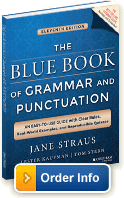|
Welcome to your GrammarBook.com e-newsletter.
|
I just want to thank you for The Blue Book of Grammar and Punctuation. I studied it and also took the quizzes on GrammarBook.com. These resources helped me pass the State test for teachers.
—Thierno T.
As a journalist, I find your GrammarBook.com lessons exceptionally helpful, particularly in my recent role as a sub-editor.
—Sam M.
I am a regular recipient of your GrammarBook.com
e-newsletter. I am a volunteer English teacher in China, and it thrills me to pass on your words of wisdom to my students, who are all very keen to learn. I want to personally thank you for your contribution.
—John A.
|
|
|
Striking the Surplus from Tautologies (Follow-Up 1)
A newsletter article in late April
addressed the matter of the tautology (also known as a pleonasm), the “needless repetition of an idea, statement,
or word.” We provided several such examples of overweight phrases and
suggested how to trim them back into shape.
Several readers responded in defense of certain phrases, sharing that what
seemed to be a modifier repeating a noun’s meaning was in fact
integral to communicative clarity.
The phrases receiving the most feedback deserve further review to support a
wider understanding of why the careful writer will work to tighten them.
Today and next week we’ll address the top three. We’ll begin
with the phrase receiving the most comments:
Contested Tautology #1: Vast Majority
Many readers felt the adjective vast is needed for the concept of
far more than half of a group. According to several, majority
alone could mean 51 percent, a slim majority. Without vast, the
reader might not realize the majority was much greater, perhaps 90 percent.
To explore the issue further, we’ll first look at common definitions
of majority from two popular sources:
[dictionary.com]
1. the greater part or number; the number larger than half the total
(opposed to minority).
2. a number of voters or votes, jurors, or others in agreement,
constituting more than half of the total number.
3. the amount by which the greater number, as of votes, surpasses the
remainder (distinguished from plurality).
[Merriam-Webster]
3 a: a number or percentage equaling more than half of a total (a majority
of voters, a two-thirds majority); b: the excess of a majority over the
remainder of the total (margin won by a majority of 10 votes); c: the
greater quantity or share (the majority of the time).
At the outset, advocating for either slim or vast to
convey the degree of a majority seems reasonable. At the same time, we want
to reinforce our mission to be careful, attentive writers and grammarians.
This involves being specific to avoid varying interpretations.
To that aim, we’ll ask ourselves what a vast majority is. To
some, it could be 67 percent; to others, 73 percent; and to yet others, perhaps the most
justified, 92 percent.
Conversely, a slim majority could be perceived as 59 percent, 62 percent, or,
among the most justified, 51 percent.
Rather than write "The bill passed by a slim majority," write "The bill
barely passed with 52 percent of the vote." Rather than write "A vast majority of
stockholders believe company leadership should change," write "Eighty-three
percent of stockholders believe company leadership should change" or "More
than three-fourths of stockholders . . ." Such specifics serve your readers
(or listeners) to a greater effect.
The noun phrase can still be classified as a tautology depending on how the
definition of majority is being applied. However, we also expand
the matter to be one of precision (as opposed to solely an instance of a
repetitive noun and modifier).
We put forth that potentially tautological phrases such as slim majority and vast majority are acceptable in writing
if they are supported by information that specifies what the slim
or vast majority is—e.g., charts, graphs, percentage numbers
in text.
Next week we’ll revisit the tautologies identical match and invited guest.
Because of the e-newsletter’s large readership, please submit your comments or questions regarding today's (or any past) article through GrammarBook.com’s Grammar Blog
|
|
Free BONUS Quiz for You!
[[firstname]], because you are a subscriber to the newsletter, you get access to one of the Subscribers-Only Quizzes. Click here to take a Who, Whom, That, Which Quiz and get your scores and explanations instantly!
More Good News for Quiz Subscribers
We are pleased to announce that we have added even more quizzes to help you challenge yourself, your students, and your staff. We added quizzes to existing categories and created some new categories such as “Vocabulary,” “Spelling,” “Confusing Verbs,” “Subjunctive Mood,” “Comprise,” and “Sit vs. Set vs. Sat.”
We reviewed and strengthened every quiz on our website to ensure consistency with the rules and guidelines contained in our eleventh edition of The Blue Book of Grammar and Punctuation.
If you think you have found an error in a quiz, please email us at help@grammarbook.com.

“GrammarBook's subscription quizzes opened a new door for me, a way to see exactly who is doing the work and who isn’t, and it is very convenient for the students.”
“So convenient … hundreds of quizzes in one click.”
[[firstname]], Subscribe to receive hundreds of English usage quizzes not found anywhere else!
- Take the quizzes online or download and copy them.
- Get scored instantly.
- Find explanations for every quiz answer.
- Reproduce the quizzes to your heart’s content.
- EASY to use.
- No software to download.
- No setup time.
- A real person to help you if you have any questions!
Instructors and Employers: we make your life easier!
- Assign quizzes to your students or employees.
- Students log in from anywhere.
- Scores are tallied and compiled for you.
- You decide whether to let students see their own scores and quiz explanations.
- Let GrammarBook.com take the hassle out of teaching English!
“Fun to test my skills!”
“The explanations really help … thanks!”
Your choice: Subscribe at the $29.95 or $99.95 level ($30 off - previously $129.95).
“I download the quizzes for my students who don’t have computer access.”
Subscribe today to receive hundreds of English usage quizzes not found anywhere else!
“Makes learning English FUN!”
 |
Don’t need all the quizzes at once?
You can now purchase the same quizzes individually for ONLY 99¢ each. Purchase yours here. |

Get Yours Today!
Get Amazon’s No. 1 Best-seller in Four Categories!
No. 1 in Grammar
No. 1 in Reading
No. 1 in Lesson Planning
No. 1 in Vocabulary |
The Blue Book of Grammar
and Punctuation
by Jane Straus, Lester Kaufman, and Tom Stern
The Authority on English Grammar!
Eleventh Edition Now Available
Have You Ordered Your Copy Yet?
An indispensable tool for busy professionals, teachers, students, homeschool families, editors, writers, and proofreaders.
Available in print AND as an e-Book! Over 2,000 copies are purchased every month!
Order Your Copy Today!
- Hundreds of Grammar, Punctuation, Capitalization, and Usage Rules
- Real-World Examples
- Spelling / Vocabulary / Confusing Words
- Quizzes with Answers
The publisher of The Blue Book, Jossey-Bass, A Wiley brand, is offering a 35 percent discount for those of you who order the book through Wiley.com. Shipping and tax are not included. Simply go to bit.ly/1996hkA and use discount code E9X4A.
*Offer expires December 31, 2017.
|
Wordplay

Learn all about who and whom, affect and effect, subjects and verbs, adjectives and adverbs, commas, semicolons, quotation marks, and much more by just sitting back and enjoying these easy-to-follow lessons. Tell your colleagues (and boss), children, teachers, and friends. Click here to watch. |






